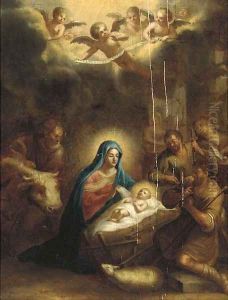Francis Verwilt Paintings
Francis Verwilt was a Flemish painter born in 1623 in Antwerp, a city then renowned for its vibrant artistic community. His life and work are situated within the Baroque period, an era characterized by dramatic expression, rich coloration, and intense interplay of light and shadow. Verwilt's contributions, although not as widely recognized as some of his contemporaries, play a significant role in the tapestry of Flemish art history.
Verwilt received his early training in the bustling workshops of Antwerp, a city that was a crucible for artistic talent during the 17th century. It was here that he honed his skills, absorbing the influences of the Baroque giants like Peter Paul Rubens and Anthony van Dyck. These influences are evident in Verwilt's adept use of color and mastery of dramatic lighting, hallmarks of the Baroque style. Despite the shadow cast by these towering figures, Verwilt developed a distinct style, often focusing on religious and mythological themes, which were popular among his clientele.
Throughout his career, Verwilt remained primarily in Antwerp, contributing to the city's artistic legacy. He became a master in the Guild of Saint Luke, a prestigious guild for painters, sculptors, and other artists, which underscored his status as a respected artist of his time. His works were sought after by the local nobility and the church, leading to numerous commissions that included altarpieces, portraits, and historical scenes.
Unfortunately, much of Francis Verwilt's work has not survived the test of time, and his name is not as prominent in the annals of art history as some of his contemporaries. However, the existing pieces serve as a testament to his skill and the vibrancy of the Flemish Baroque movement. Verwilt's legacy is that of a skilled painter who contributed to the richness of Flemish art, embodying the opulent and dynamic spirit of the Baroque era.
Francis Verwilt passed away in 1691. His death marked the end of a life dedicated to art, leaving behind a body of work that, though not extensive, provides insight into the artistic endeavors of the Flemish Baroque period. While Verwilt may not have achieved the lasting fame of Rubens or Van Dyck, his work remains a valuable piece of the puzzle in understanding the artistic landscape of 17th century Flanders.
